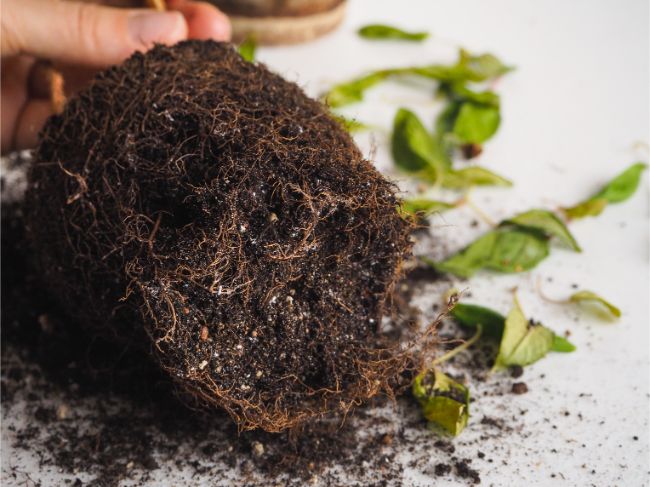Root rot is one of the most damaging ailments our houseplants can suffer from, and one of the most common. An infection can destroy a plant literally from the ground up. It spreads quickly, and without prompt action it’s soon too late.
Prevention is the best policy, but the disease can be stopped if caught early. In this article, we’ll explain what root rot is and how it happens, how to diagnose and treat it … and, most importantly, how to prevent it.
What Is Root Rot?
Root rot happens when your plant’s roots succumb to pathogens of decay. The disease turns affected roots into a brown or black mush that can’t transport nutrients to the rest of the plant. Its progression is fatal.
Root rot can quickly spread to the rest of the plant. The disease may be caused by many different viruses, bacteria, fungi, and oomycetes (water molds). A few common baddies are Fusarium, Pythium, Phytophthora, and Rhizoctonia—but it doesn’t matter as far as basic treatment goes.
Container living makes a plant especially vulnerable, but these pathogens aren’t picking on houseplants: they cause enormous economic damage to crops worldwide. The artificial environment of a container can promote infection, so you have to be careful to ensure your green babies aren’t sitting ducks.
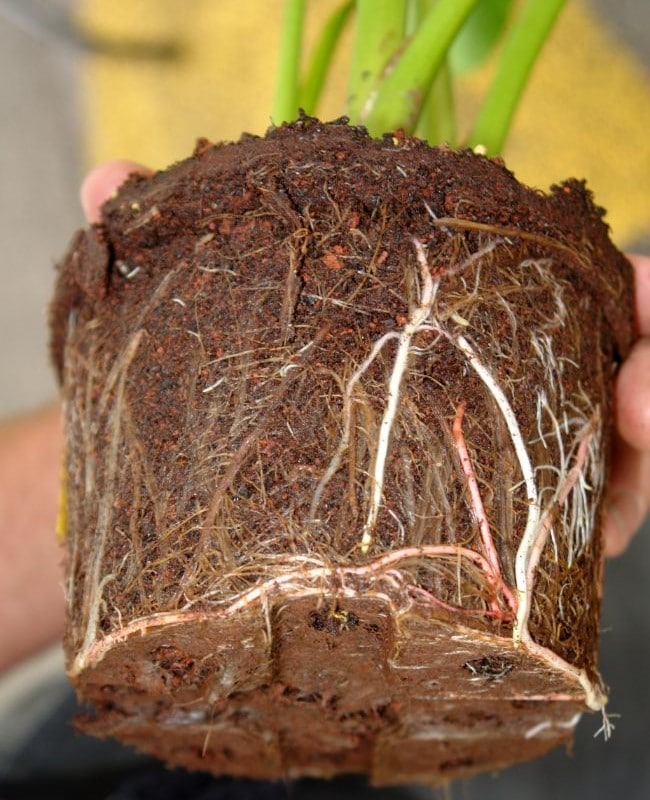
What Causes Root Rot?
Root-rotting pathogens thrive in moisture, so soggy conditions typically get the ball rolling. Here are important contributors to infection:
Overwatering
This is the big one: Giving a plant more water than it can handle is the classic setup for rot. Overwatering both suffocates the roots and lowers the soil’s oxygen level, effectively setting the table for opportunistic pathogens.
Poorly Draining Soil
Heavy soils hold water. This tendency to stay waterlogged (and dry to a cement-like hardness) is why well-draining soil is specifically recommended for most plants: perpetually wet roots are primed for root rot.
Inadequate Drainage
Houseplant containers should have drainage holes to let excess water escape. Placing stones at the bottom doesn’t work: it only preserves a layer of stagnant water below the roots.
Oversized Pots
You may be tempted to give your plant extra growing room (and save yourself some future repotting effort), but this isn’t usually a good idea. Excess soil can breed problems, as empty space can become a waterlogged dead zone.
Non-porous Containers
Clay pots can be cumbersome but have one big advantage: they are permeable. Water can evaporate through their walls to let the soil breathe. Non-porous pots like plastic or glazed containers trap moisture and promote soggy conditions.
Failure To Empty Caches
A saucer or cache pot placed under a houseplant’s container can protect the underlying surface from water drainage, but may also leave the soil sodden if it remains in contact with the runoff.
Pro Tip: One useful safety practice is to place the pot on pebbles that elevate it above the water line. This helps increase local humidity, too.
Cool Temperatures
Regular watering can be too much if the temperatures drop. This may not be an issue in the controlled climate of your home, but remember that both water consumption and evaporation are higher in warmer weather.
Poor Air Flow
Air circulation also increases evaporation rates: stagnant air can lead to soggy soil. This issue can be caused by grouping plants to raise local humidity, because crowding can also lead to poor ventilation and soil that stays wet for too long.
Planting Too Deep
In many species, burying the stem invites decay. This isn’t true for every plant—some will root along a buried stem—but you should check your houseplant’s specifications before lowering its planting depth.
Watering Out Of Season
Many plants have seasonal periods when their growth slows or they enter dormancy. They require less water during these times, so continuing the same watering schedule can mean unintentional overwatering.
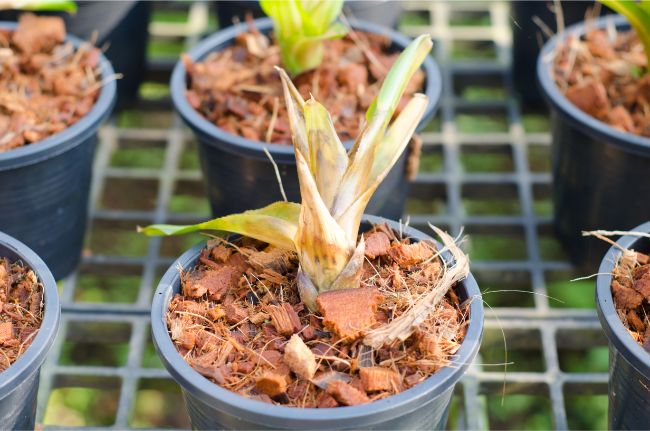
Other Contributors To Root Rot
Moisture provides a breeding ground for root rot, but there are other ways your plants might become infected:
Contaminated Tools
It’s important to disinfect your equipment before reusing them with other plants. Pathogens cling to pots, shears, trowels, and other tools and can easily jump to other plants if they aren’t sterilized.
Buying Sick Plants
More than one gardening tragedy has begun with bringing home a simple retail purchase. The early stages of root rot can be difficult to detect, but stay away from plants with wilted leaves or puffy areas on the stems. Try to buy only from reputable dealers, and it’s a good idea to quarantine a new purchase away from other plants until you’re sure it’s healthy.
Compromised Soil
Pathogens live in the soil waiting to spring. Commercial mixes are usually sterile, but avoid using soil from your garden or recycling the medium without sterilizing it first. Store potting soil in an airtight container to prevent contamination.
Weakness Or Stress
Root rot is largely an opportunistic infection. Besides invading a plant that’s been stressed through overwatering, pathogens can take advantage of over- or under-fertilization, droughts, physical damage, or even a change in light or other environmental factors. Keeping a plant healthy is the best way to ward off trouble.
Symptoms Of Root Rot
Early detection of root rot is critical to recovery; unfortunately, the first stages of the disease happen out of sight.
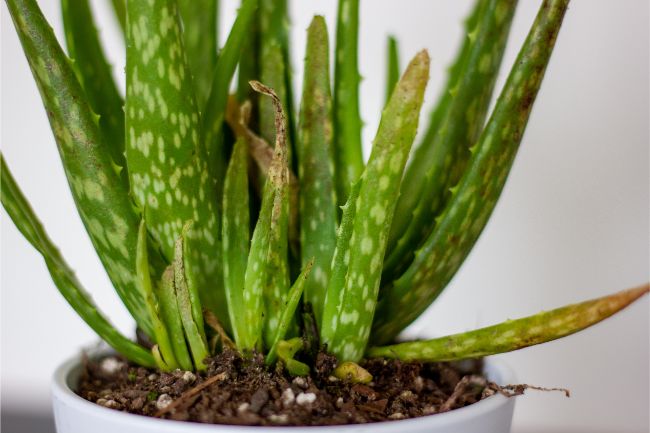
Early Warning Signs Of Root Rot
Slow growth is one general indication the roots might be struggling. Yellowing leaves are another early warning. Check the soil if you see leaf discoloration.
Soil that stays wet could also indicate a problem down below. Leaves that curl during the day but seem to recover overnight is another warning sign.
Root Rot Red Alert
Swollen, mushy stems and wilting leaves are classic alarms that the disease is underway. Since the plant literally rots from the bottom up, the plant’s lower portions show symptoms first. The entire root system may not yet be affected—though, without intervention, it soon will be.
If you suspect root rot, gently remove the topsoil for examination and check the roots. The typical progression is that the normally healthy white roots start to become limp instead of crisp. They will usually turn yellow before becoming brown or black. The root’s brown covering can often be easily pulled off to reveal inner tissue.
The smell of decay is another signal of root rot. It becomes increasingly obvious as the disease progresses—once you know the smell, it may help you to recognize the problem sooner. Healthy roots are odorless or have an earthy scent.
The End Game
Late stage infection turns the roots into mush. If not stopped, the whole plant will eventually topple over. In advanced cases, when you check the stem it may simply come off in your hand.
How To Fix Root Rot
Treat root rot by removing your plant from its pot and washing the old soil from the roots. Cut all the diseased roots from the plant with sterile pruners, leaving only healthy roots. Then repot the plant in a sterile pot with fresh, well-draining soil and avoid overwatering.
The specifics of treatment depends upon the severity of the condition. Early detection allows for less invasive remedies.
In all cases, the first rule of root rot is to treat it immediately. Speedy intervention helps you save as much of the plant as possible. A day can make a difference.
Keep the plant out of intense light during treatment. Also, withhold fertilizers until the plant is healthy again: the roots are compromised and won’t deliver the nutrients properly.
Treating Mild Root Rot
Perhaps your plant is languishing and you notice the soil stays wet … but there isn’t a definite smell or puffy stems or other surefire signs of rot. In that case, it’s time to back off watering and watch the plant closely.
Mild infections can sometimes be reversed by simply letting the soil dry and changing your watering practices. This avoids the disruption of repotting which can complicate a weakened plant’s recovery.
Remove any mulch or fallen material on the topsoil to allow better evaporation. The idea is to deprive any developing pathogens the excess moisture they need and to let your plant’s natural defenses finish them off.
Make sure there is good airflow over the pot. If the medium is very wet, consider gently taking the plant’s soil temporarily out of the pot. Leave it together in a block, and set it on a newspaper. This helps the soil dry more quickly and gives the roots extra oxygen. A fan will speed the process.
Treatment Of Severe Root Rot
If the rot is extensive but there are still living roots, it’s time for desperate measures: You will need to repot your plant, while removing all affected roots and foliage. Bear in mind that repotting brings on another wave of plant stress, so proceed as gently as possible.
Here are the steps:
- Remove the plant from its pot and inspect the roots.
- Wash the root ball to remove the infected soil.
- Cut away mushy or brown roots with sterilized shears. (Re-sterilize after use!)
- Cut off wilted or discolored leaves.
- Trim off buds and flowers along with about 50% of the leaves so the remaining roots can service the plant adequately.
- Repot in fresh, dry, well-draining soil. Give it medium light and carefully restart your watering regimen.
- Carefully resume a light watering schedule.
- Isolate the plant and keep it under observation. If rot returns … say goodbye and discard the plant safely.
Remember: the plant will need less water because it now has fewer roots.
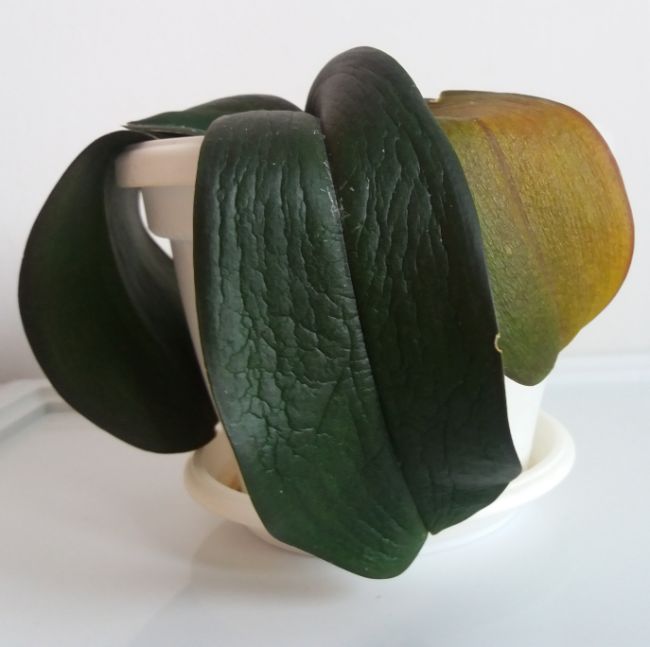
Very Severe Root Rot
Very severe cases are the easiest to treat, since it involves throwing the plant away. Don’t let it come into contact with your other plants. Sterilize pots and other equipment that touched it and discard its soil. Short and sad.
Advanced Root Rot Treatments
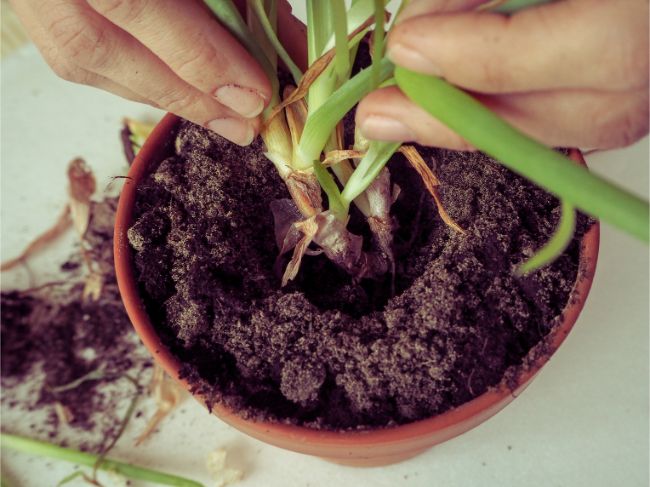
Commercial Fungicides To Treat Root Rot
Commercial fungicides can be effective, but there caveats.
First of all, no single chemical treats every kind of fungus. The condition could even be caused by a bacteria or virus.
If you wish to spend the effort and money – and have enough time left – a professional can identify the specific pathogen attacking your plant. Some nurseries offer this service. Without this diagnosis, however, anti-fungal applications are a shot in the dark.
The chemicals aren’t inexpensive, either.
Finally, fungicides can damage beneficial soil organisms. This can, ironically, make your plants more susceptible to rot.
Natural Root Rot Remedies
If you’d prefer to manage the problem using natural methods, there are quite a few options to try. Many gardeners have great results with natural treatments, while others will say they are of little use.
Cinnamon
Everything has an exception: Good old cinnamon appears to be a natural fungicide with low toxicity. It may sound strange, but experienced gardeners swear by cinnamon for reducing soil gnats, protecting seedlings … and preventing root rot.
This common kitchen spice has proven effective against fungal infections on over 40 different crops. The active ingredient’s formal name is cinnamaldehyde.
To treat your troubled houseplant, dust cinnamon over roots and other affected plant parts after the diseased areas have been trimmed away. Don’t forget to mix some in the soil, too.
Chamomile
As you begin to carefully water your recovering plant, you may consider adding some chamomile tea. Some growers report using the solution successfully as a natural microbial and mild fungicide. It’s claimed that chamomile acts much like cinnamon, but in liquid form.
Hydrogen Peroxide
The commonly available 3% solution of Hydrogen Peroxide is another potential root rot treatment that adds oxygen and helps fight the infection. Hydrogen Peroxide is commonly used to combat root rot in hydroponic setups and may be effective for regular houseplants, too.
Dilute about 1-1/2 teaspoons of 3% solution in a cup of water and spritz the affected leaves and stems. You can also drip this solution into the soil.
Be aware this treatment may also kill beneficial organisms, and its effectiveness in soil is variable. As a last ditch effort, some gardeners dip the roots of a severely infected plant in diluted solution before repotting.
How To Prevent Root Rot
The best approach to root rot is prevention, which is mostly about avoiding mistakes. Here are the requirements to avoid needing this article again:
Sterilized Well-Draining Soil
Few plants appreciate heavy sludge in their pots. Luckily, heavy soil is not difficult to fix.
You can imagine potting medium as being on a spectrum between impermeable, water-holding clay to completely porous sand—most plants favor a mix that falls somewhere in the middle. Drainage quality can be adjusted by adding sand, perlite, bark, or other coarse amendments to open up heavy clay soil, and vice versa.
Organic amendments like worm compost and leaf mold work to “correct” either type of soil so that it drains optimally. Organic material also offers the bonus of natural fertility.
Correct Watering
Don’t just water all your houseplants at once. Succulents need less water than many tropicals—and even potted water hogs don’t like to be constantly wet.
It’s best to saturate the pot and let it drain thoroughly. Allow the topsoil to dry between waterings. Remember to water less in cooler weather or during dormancy.
Learn everything you need to know about watering your houseplants the right way in this article.
Proper Potting
A plant’s proper container size is determined by the scope of its root system. Tubers, epiphytes and many succulents have limited roots, but others go deep.
Too much “empty” soil is problematic because, without roots to take up water and aerate the soil, dead zones can develop where root rot may take hold. One size doesn’t fit all, so know your plant.
Also, as mentioned, clay pots are best because they allow water to evaporate through the side and let the soil breathe.
Give Them Room
To make sure your plants don’t live in stagnant conditions (or contaminate each other), ensure there’s good air flow around them.
Plant Choice
Your choice of plants matters, too: some are more susceptible to root rot than others.
Cactus and other succulents naturally need less watering than most plants, for example, which makes their roots prone to disease in waterlogged conditions. An epiphyte’s weak roots are mostly for anchoring instead of absorbing water and nutrients, so they also develop root rot easily.
If you aren’t in full control of your watering can, stick with moisture-loving plants. It’s hard to overwater Peace Lilies, for example, and many ferns love constantly moist conditions. Just remember that even plants that like frequent watering don’t appreciate overly soggy soil.
Observation
The most important weapon against root rot is consistent observation. Even experts admit their failures have come mainly from inattention.
Develop the habit of watching your plants and taking appropriate action. Check out irregularities in their growth or coloring. Monitor how quickly the topsoil dries out and get used to their rhythm of water use. Look for signs of dormancy.
Plants don’t talk, but they do communicate. Becoming a greenthumb requires learning their language. You can usually avoid the anguish, the guilt—and the smelly mess—of root rot by simply paying attention.

